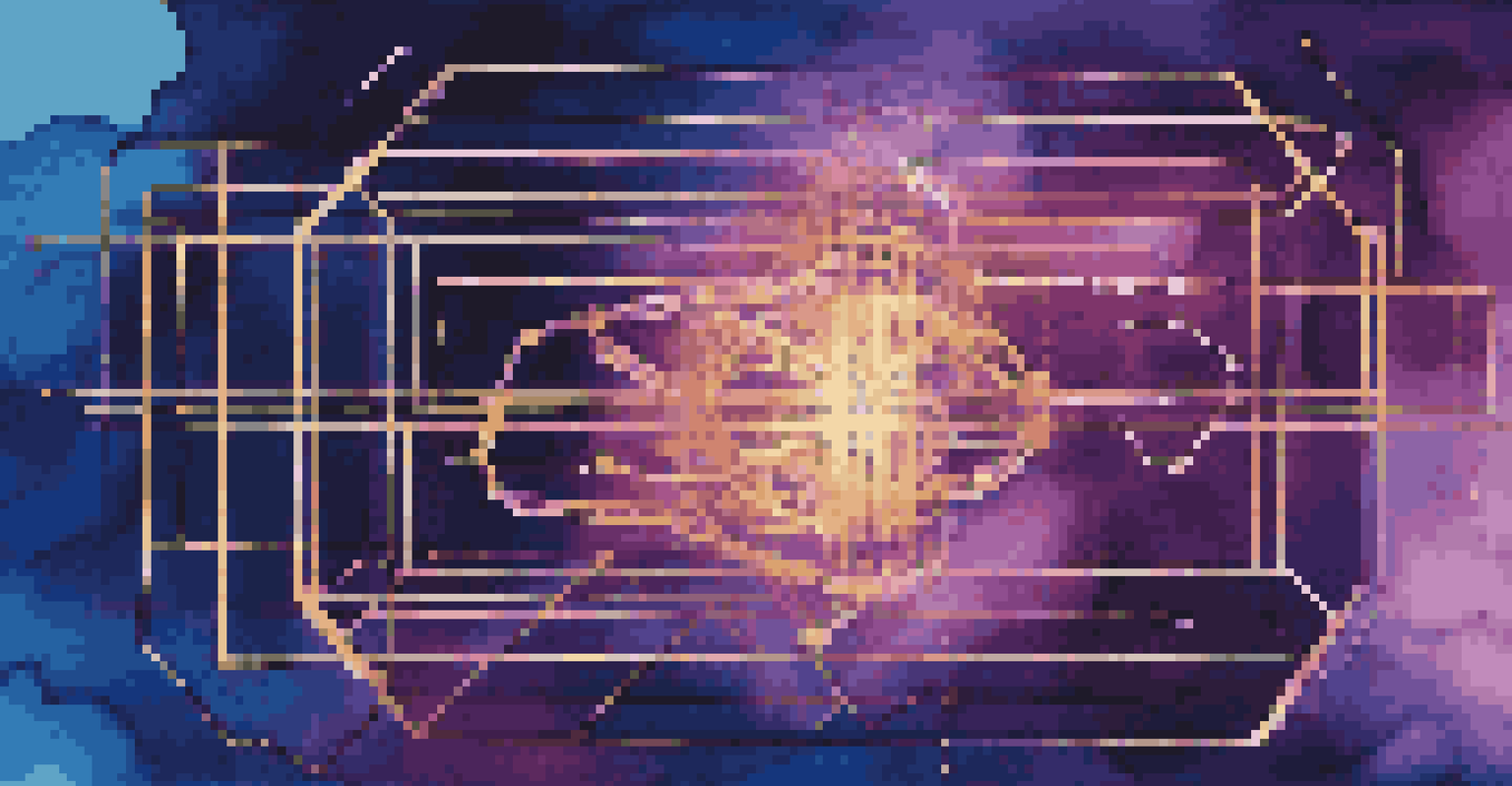The Challenges of Valuing Luxury Digital Art

Understanding Luxury Digital Art and Its Appeal
Luxury digital art represents a unique intersection of creativity and technology, captivating collectors worldwide. With the rise of NFTs (non-fungible tokens), artists can now create and sell digital pieces that hold intrinsic value. This new form of art allows for ownership verification and provenance, which are essential in the luxury market. However, its digital nature often raises questions about authenticity and rarity, which can complicate valuation.
Art is not what you see, but what you make others see.
The allure of luxury digital art lies not just in its aesthetics but also in the status attached to ownership. Just as a classic painting can symbolize wealth and taste, owning a high-value NFT can signify a collector's savvy in the digital realm. This dynamic has led to a growing interest among affluent buyers who see value in both the art and the technology behind it. Yet, many still struggle to grasp how to appraise these digital works accurately.
As we delve deeper into this emerging market, it's crucial to understand the factors that contribute to the perceived value of luxury digital art. These include the artist's reputation, the uniqueness of the piece, and the market demand. By grasping these elements, collectors can make informed decisions, but the subjective nature of art still leaves room for debate, making valuations all the more challenging.
Market Volatility and Its Impact on Valuation
The digital art market is known for its volatility, with prices sometimes skyrocketing or plummeting overnight. This unpredictability can make it difficult for collectors to determine the true value of a piece. Factors such as trends in technology, changes in consumer interest, and broader economic conditions all play a role in this fluctuation. Just like the stock market, one day a piece might be worth thousands, and the next, it could drop significantly.

This volatility can discourage potential buyers and make seasoned collectors wary. For instance, if someone invested heavily in a digital artwork only to see its value decrease, it could lead to substantial financial loss. Consequently, many collectors are adopting a cautious approach, often waiting for the right moment to buy or sell. This hesitancy can further complicate the overall valuation process.
Value of Digital Art is Complex
The valuation of luxury digital art is influenced by various factors including market demand, artist reputation, and the authenticity of the pieces.
On the flip side, some collectors thrive on this market volatility, viewing it as an opportunity for profit. They often engage in speculation, purchasing pieces they believe will appreciate in value over time. This speculative behavior adds another layer of complexity, as it intertwines personal taste with financial strategy, making the valuation of luxury digital art a blend of art appreciation and investment acumen.
The Role of Authenticity in Valuing Digital Art
In traditional art markets, authenticity is often established through certificates, expert appraisals, and historical provenance. In the world of luxury digital art, authenticity is secured through blockchain technology, which verifies ownership and ensures that a piece is indeed one-of-a-kind. However, despite this technological advantage, questions about authenticity can still arise, especially with the rise of forgeries and copies.
The future belongs to those who believe in the beauty of their dreams.
For collectors, understanding how authenticity affects value is crucial. A piece that is verified as an original NFT can command a significantly higher price than a replica or an unauthorized copy. This makes it essential for buyers to do their due diligence before investing, ensuring that the piece they are interested in is legitimate. However, the digital realm can sometimes blur these lines, leading to confusion regarding what constitutes an authentic work.
As the market matures, the importance of authenticity in valuation will only grow. Collectors and investors are increasingly seeking ways to educate themselves about the nuances of blockchain and NFT technology. This knowledge can empower them to navigate the complexities of the digital art world, making more informed choices that reflect both their aesthetic preferences and financial goals.
Cultural and Societal Influences on Digital Art Value
The value of luxury digital art is not determined solely by market trends or technical aspects; cultural and societal factors play a significant role as well. As digital art becomes more mainstream, its perception shifts, influencing how collectors view its worth. For instance, the rise of social media platforms has amplified artists’ visibility, allowing them to reach a wider audience and build their reputations faster than ever.
Cultural movements and societal issues also influence the themes artists explore, which can enhance a piece’s significance and, consequently, its value. For example, artworks that address climate change or social justice can resonate deeply with collectors who prioritize these issues. As collectors align their purchases with their values, the demand for such pieces can drive up their valuation in the market.
Market Volatility Affects Pricing
The digital art market is highly volatile, making it challenging for collectors to determine the true value of artworks amidst fluctuating prices.
Furthermore, the democratization of art through technology allows more individuals to participate in the digital art scene. This inclusivity can lead to diverse tastes and preferences, creating a dynamic market where value can shift rapidly. As digital art continues to evolve, understanding these cultural and societal influences will be key for collectors seeking to navigate this complex landscape effectively.
The Challenge of Comparing Digital Art to Traditional Art
When it comes to valuing luxury digital art, one of the biggest challenges is comparing it to traditional art forms. Traditional art has well-established metrics for valuation, such as historical significance, medium, and artist reputation. Digital art, however, is still carving out its own space, often making it difficult for collectors to draw parallels and make informed decisions based on past experiences.
This challenge is compounded by the fact that digital art can take many forms, from animated pieces to interactive installations. Each type requires different criteria for evaluation, which can lead to confusion about how to assess value accurately. For instance, a digital painting may have different valuation parameters compared to a digital sculpture or a virtual reality experience, complicating the art market landscape.
Moreover, the fluidity of digital art—where pieces can be altered or remixed—adds another layer of complexity. Unlike a traditional painting that remains static, digital art can evolve, which raises questions about its longevity and ultimate value. As collectors grapple with these differences, finding a common ground for comparison becomes essential, yet remains a significant hurdle in the valuation process.
Emerging Technologies Shaping Digital Art Valuation
Emerging technologies are revolutionizing how we value luxury digital art, offering innovative solutions to some of the challenges discussed earlier. For instance, artificial intelligence (AI) is increasingly being used to analyze market trends and predict future values based on historical data. This technology can provide insights that help collectors make more informed decisions, potentially leading to more stable valuations.
Another exciting development is the use of augmented reality (AR) and virtual reality (VR) in showcasing digital art. These technologies allow potential buyers to experience artworks in immersive ways, enhancing their appreciation and understanding of the pieces. This shift can influence perceived value, as collectors may be willing to pay more for works that engage them on multiple sensory levels.
Cultural Trends Shape Perception
Cultural and societal influences significantly impact how collectors perceive the value of digital art, often aligning purchases with personal values and beliefs.
Moreover, blockchain technology continues to evolve, providing more secure and transparent ways to verify authenticity and ownership. As these technologies become more integrated into the digital art landscape, they will likely play a crucial role in shaping how we value these unique pieces. Collectors who stay ahead of these trends will not only enrich their understanding but also enhance their investment strategies.
The Future of Valuing Luxury Digital Art
As we look ahead, the future of valuing luxury digital art appears both exciting and uncertain. With rapid technological advancements and shifting cultural landscapes, the way we perceive and value digital art will continue to evolve. Collectors and artists alike will need to adapt to these changes, embracing new tools and methodologies to navigate the complexities of the market effectively.
One key aspect of this future is the potential for more standardized valuation methods. As the digital art community matures, there may be a push for established guidelines similar to those used in traditional art markets. Such standards could help demystify the valuation process, making it more accessible for both collectors and artists while fostering greater trust in the market.

Ultimately, the journey of valuing luxury digital art will be shaped by a combination of technology, market forces, and cultural influences. As we embrace these factors, it’s essential for collectors to remain informed and engaged, ensuring they can navigate this vibrant and evolving landscape with confidence. The potential for innovation and creativity in this realm is vast, offering exciting possibilities for the future of art ownership.